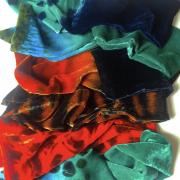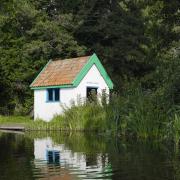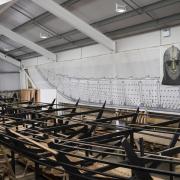Sophie Sims makes beautiful jewellery from sea glass she finds on the beach near her home, a passion that started as a distraction from a childhood illness and is now turning her into a budding art entrepreneur.
Glowing uranium glass, vintage opalite, dragon egg with effervescent colour, and red with gold mixed in for Victorian opulent Victorian vases. The sea-washed fragments found by Sophie Sims on Suffolk beaches tell a thousand stories from a bygone age. Sophie is just 13, but already becoming quite an expert on the glass that has rolled and tumbled in the sea for decades, or even centuries, until worn and frosted, it washes up on our beaches.
Little foraging sandpiper that she is, Sophie revels in the thrill and intrigue of discovering sea glass among the pebbles or just under the sand when the tide goes out. 'My mum always says I look like a sandpiper when I go in and out of the wash because I always run away from the waves,' she giggles. 'I really love birds as well.' So that’s how she came to call her enterprise The Little Suffolk Sandpiper.

Where does the glass come from? How far has it travelled? Who was the last person to have held it in their hands? These are the questions Sophie sets herself when she spots the gleam of another discovery. 'I can pick up glass that’s maybe a few hundred years old. You can tell the difference because of the opaqueness, the shape and just how it feels really.'
How did the beach foraging start? Sophie is more than happy to reveal something of the tragedy to triumph story that found her creating the beautiful pieces she has sold successfully at farmers’ markets, along with her mum Helen Sims of Suffolk Meadow Flowers.
'When I was 10, I got diagnosed with colitis and while the doctors were looking for something that might help, one of the doctors suggested taking a walk. So my mum took me for a long walk on the beach.

'I was really sad at that time so I had my head hung down. That’s when I saw something shining in the sand and, when I picked it up, it was a light green piece of sea glass. It was too rounded for modern glass and, when I got home, I did some research and found it was Victorian glass, which was really cool.' It was the start of a remarkable journey for Sophie.
'By the time I was 12, I had a big collection of glass. When I showed it to my mum, she said they kind of looked like jewels so I could try to make jewellery out of them.' For Sophie, it was an irresistible challenge. She worked long hours 'doing chores' to earn enough money to buy a drill, a diamond drill bit and some sterling silver. That determination saw her through the steep learning curve to produce her first piece.
'While drilling the glass, I smashed four pieces. They just completely shattered. It’s really hard to do. And on the fifth piece I drilled, it was perfect, and I spent another hour shaping the hole so a clasp could go on it.' She gifted it to her mum. Helen proudly shows me a very fine necklace, in grey glass with an elegant silver clasp.

'One of the rarest colours and I didn’t know that at the time,' says Sophie. It was a fitting reward for Helen, whose home schooling of Sophie has included advice on becoming an entrepreneur, to enable her to have a brighter future, despite the pain and stress of her life-long colitis. Sea glass is clearly a wonderful distraction, so it was no surprise when Sophie took up the next challenge of selling her pieces at Wyken Vineyards Farmers’ Market.
'I took six necklaces and it took ages before I sold any, but then I suddenly sold four pieces all in one day. I was really happy because I was able to invest it all in my glass, like getting more silver for the jewellery and more tools.' This is the thing about Sophie, the sandpiper, the entrepreneur. She has never expected hand-outs from her parents. 'I never really want any help because I want to make sure I can do it by myself,' she says.
Hunting along the beach, as the waves roll in, I wonder how Sophie spots her glass fragments. 'A good way to do it is by looking at the outline because the outline of the glass glows in its colour, so if you find white, it’s clear in the sand and the outside of the glass will be glowing white.'

And the colours? What can they tell you? 'Well you can’t really tell much, but there’s definitely lots of rarities in the glass – like red glass. They used gold to make red in the Victorian times.' We then get on to Seaham glass. I’ve read that Seaham in Co Durham boasted the largest glass bottle works in Britain in the 1850s, including perfume bottles and household glass in myriad colours, the waste routinely dumped in the sea. Could this have drifted down to Suffolk?
'Rare chance, but yes it can happen,' says Sophie. 'After more than a hundred years, Victorian glass would have travelled far.' And who knows what broken bottles, tableware and fancy glass goods may have come from shipwrecks?
'Because I love history, I do research on all the glass. I look mostly for Victorian glass. You can tell the difference between like the opaqueness, the shape and just how it feels really.' She uses coconut oil to make frosted glass clearer to better reflect the light and accentuate the colour. And her most exciting find?

'I have two pieces of Edwardian opalite glass, which is white but has a hue of gold or green. You get different hues in the glass and it’s just really amazing. And Dragon egg glass can look really different. It can look like a dragon egg and they have, like, an exploding star shape on them.' It’s another of her favourite finds.
Sophie understands how different colours are created by different minerals and elements, like the cobalt pigment for cornflower blue, of which she has some examples, and the uranium oxide used for the yellow or greenish glass, first used in the 1830s. She explains how it will glow in the dark when exposed to ultraviolet light. 'I only have one piece,' she says. And there’s more. Milk glass is extremely rare and looks almost like plastic. 'Well, it’s milky really. I only have two very small pieces.'
Helen is immensely supportive of Sophie’s artistic enterprise and has provided a special space in the acre of garden where she runs her flower farm. 'I have a little shed outside,' says Sophie. Well, let’s call it a studio, as inside Sophie drills her glass fragments – safely in water so the particles don’t fly into the air. She has also learned the art of soldering, shown off to perfection in a beautiful Italian necklace, and the technique of silver wire twisting using long-nose pliers.

'That’s why I need loads of tools,' she says. Silver smelting is her next goal so she can make her own charms. But actually, the next challenge is to find Sophie some formal training to develop her work. 'You have to be over 18 for a silver-smithing course at college,' she says. For this entrepreneurial mum and daughter, there’s bound to be a solution.
Sophie’s work can be seen on Instagram and Facebook and she can be contacted at suffolkmeadowflowers.co.uk/the-little-suffolk-sandpiper/



























